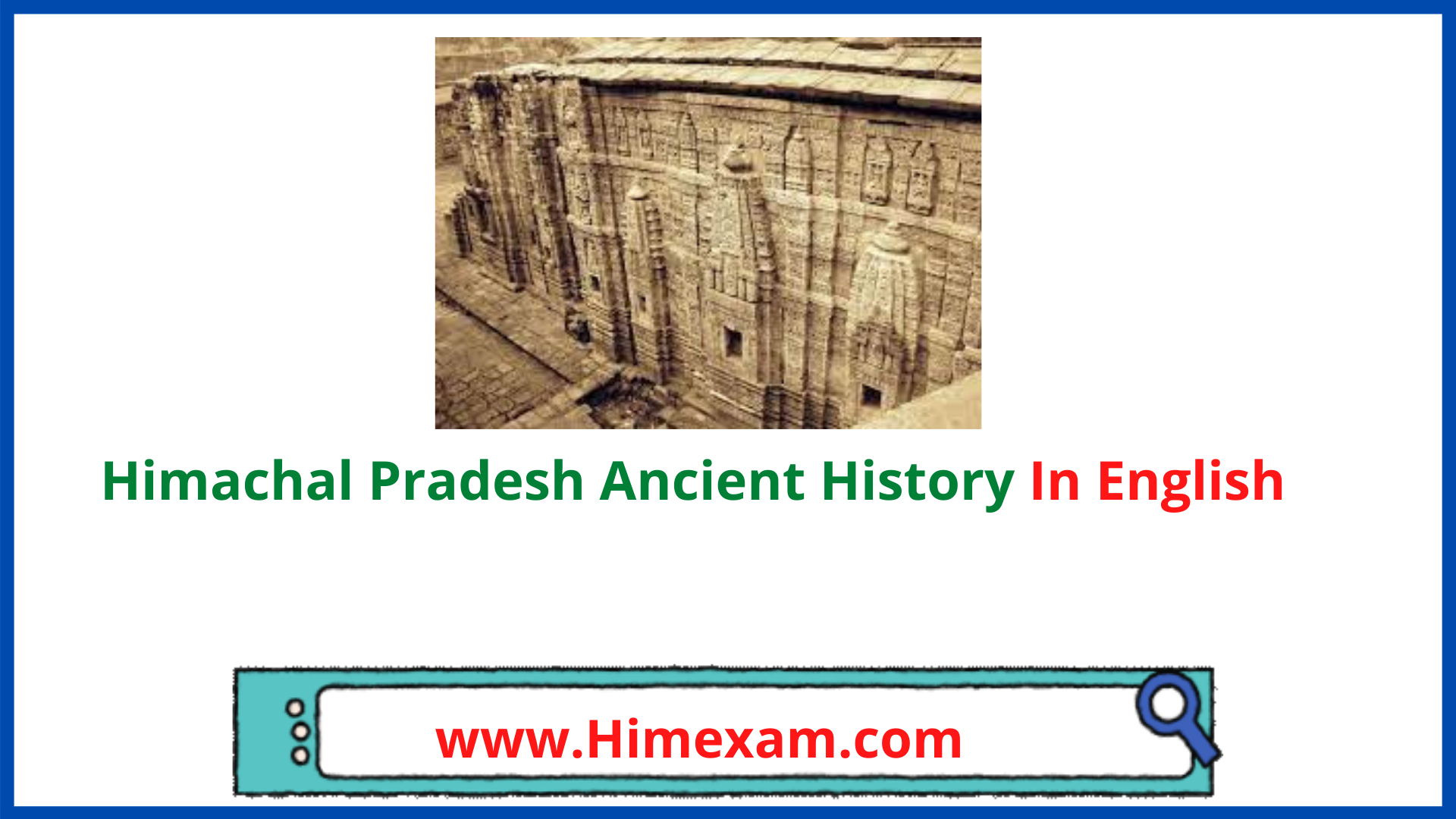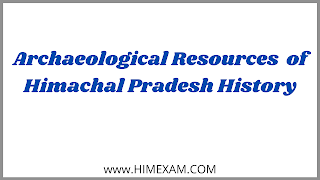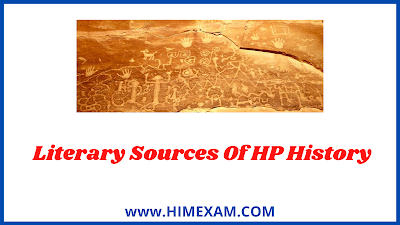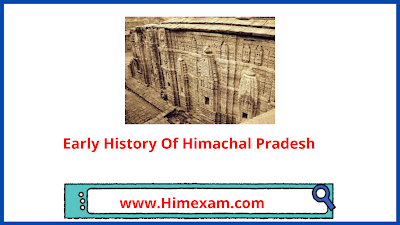Himachal Pradesh Ancient History
||Himachal Pradesh Ancient History ||HP Ancient History In English||
Archaeological Resources of Himachal Pradesh History
The sources of history of Himachal Pradesh are divided into two categories i.e. Archaeological Resources and Literary Resources. There are two main sources of history of Himachal Pradesh. These are discussed below:
i. Archaeological Sources
ii. Literary Sources
i. Archaeological Sources :-Archaeological remains provide the most reliable evidence for knowing the history and the level of cultural and economic attainment of people of a region. Archacological discoveries, inscriptions temples and coins are some archaeological resources which provide information about the history of Himachal Pradesh. There sources are as follow:-
Archaeological Discoveries
About 2 million years ago, existence of human life has been proved in the Himachal foothills of Nalagarh, Suketi and Kalpa area. This is evident from the tools found from these areas during archaeological Surveys which are estimated to be 40000 years old. These evidences are also found in Guler, Dehra, Dhaliyera at Kangra in Banganga Beas valley, Sirsa-Sutlej valley of Nalagarh, Bilaspur and a valley of Sirmar
Inscriptions
A large number of inscriptions like copper plates and stone inscriptions have been found in Himachal Pradesh that dates back to the rule of Asika. Some evidence of late Palaolithic period are founded by GE Lewis, Prof Lal and Joshi and Mr Sen. Pots, pans and stone tools like axes, chisels, picks, axe-hammers and ring stones which dates back to 1.8 million years ago are found in Ror (near Kangra). The copper plates of 7th century AD isted by Maharaja Samurrasca found in Nirmand village in Kullu tells about that en Many inscriptions of Asoka are found from Pathiyar and Khaniyara in Kangra, Doonpur hillock care inscription in Hatkoti (Shimla) and Salanu near Manglor in Mandi Stone inscriptions found at Sarahan are mainly written in ‘Sharda and Tankri’script. Moreover, inscriptions are who found in Khurosthi, Brahmi, Bluustian, Naga, etc languages
Antiques or Temples
A group of fifteen rock cut temples at Mastur was discovered by HL Shuttleworth and believed to be of 8th century AD. A wooden temple at Makraha in Kulh is believed to be of 2nd century BC. Icon of Lord Vishnu found at Fatehpur (Kangra) was of 5th-6th century AD and inscriptions of 5th and 6th centuries have been found at stone temples near Chari at Kangra.
Coins
Coins are very uscful in knowing about the past. Kangra, Kullu, Chamba and Mandi state, cach had its own coinage informer times. The carliest copper coins are found in Trigarta Kingdom. It also included the cins of Menandar, Antimachus, Antialcidas, Philoxenus and Lysias along with some worn silver punch marked coins which were found in Kangra and Arki in Solan district. A large number of silver Indo-Greek coins (1-2 BC), kept in a put was found in 1970 near the village “Lacbori’ in Chamba district. From Jwalamukhi in Kangra, silver coins of Kunindas and Audumbaries were found. In 1892 at Tappa Mewa in Hamirpur district coins of Auclumbaras were found Silver and copper coins have been found in the region of Kangra valley which were related to the old Hindu Katoch Shahi rulers of Kangra. The coins bearing the names of later Kangra rulers were discovered in 1892 at Patasalian in Tchsil Palampur in Kangra district. Coins of the Ghazanavi Shiab-ud-Daula Haudad (1041-1050 AD) were also found from the Kangra valley.
Literary Sources Of HP History
Persian sources, religious sources, travelogues and genealogies are some literary resources which provide information about the history of Himachal Pradesh. These sources are as follows:
- Religious Sources:-The Hindu religious literature mostly provides information on the history of ancient Kangra. The religious literature consisting of the four Vedas, along with Aitareya Brahmana, Taittirya Samhita throw some light on the various tribes which settled along the Himalayan foothills about 2000 BC. The Puranas, Kalhana’s Rajatarangini and Vishnu Purana contain information about the old tribes of Kangra and Katoch rulers of Trigarta. According to Skand Purana, there are five natural division of Himalayas i.e. Kashmir, Jalandhar, Kedar, Koormanchal and Nepal. The Jalandhar division (belongs to Himachal Pradesh) is further divided into five divisions i.e. Jalandhar, Champak (Chamba), Kuluta (Kullu), Lahaul and Satadru. The Vishnu Purana mentions the people of Kulu as Kuluta which once formed a part of the Jalandhar. The Mahabharata also mention several religions and people of Kangra state. The Ramayana and the Brihat Samhita mention the Kuluta, Trigarta, Kangra and Jalandhara, which were once a part of the Trigarta kingdom of Susarma Chandra, the traditional founder of the Kangra. The Puranas also describes Jwalamukhi temple in Kangra valley. The Mahabharata and the Brihat Samhita describe an ancient tribe that inhabited Kangra, Nurpur, Pathankot and Chamba hills. The Rajtarangini (history of Kashmir) written by Kalhana informs us about the nature and influence of Lalitaditya (724 AD 760 AD) over the Kangra valley and Western hills. In this way these are the relevant sources of the Kangra valley and its ancient history.
- Travelogues :-The earliest and the authentic historical account of the Himalayan Hill States is found in the travelogue written by Hiuen Tsang, the Chinese traveller, who visited India during the period of Harsha in 630 AD and made important observations about the Jalandhara, Kuluta and Srughna in his book Si-Yu-Ki. A number of European travellers have left very important account of their tours which they made through different areas of Himachal Pradesh. Among them the most important are JB Eraser, Froster, Vigne, Harcourt and Cunningham.
- Persian Sources:- There are several Persian sources which describe about the Muslim Sultans and their different expeditions over Kangra fort. A large number of Persian chronicles refer to Sultan Mahamud’s invasion of Nagarkot or Bhimnagar or modern Kangra. Some Persian source include the account of wealth in temples of Kangra ex-Tarikh-i-Yamini or Kitabul-i-Yamini (1024 AD) and Khawand Mir’s Habib-us-Siyar and Farishta’s Tarikh-i-Ferishta. In the 13th century AD, a number of Persian Chronicles refer to the entry of turkish into the Shivalik hills. Many rebel nobels and chiefs took refuge in the Himalayan foothills which was mentioned in the Tabaqat-i-Nasiri of Minhajudding Siraj and Tarikh-i-Ferozshahi of Ziauddin Barani.
- Vamshavalis (Genealogies):- Normally, Rajgurus wrote Vamshavalis. Many genealogies of the Royal family of Kangra, Chamba, Mandi, Kullu, Nurpur are found here. Vamshavali of the Rajas of Kullu was edited by captain Harcourt and prepared by Hirananda Sastri. Alexander Cunningham published genealogies of Kangra, Nurpur, Mandi, Suket, Chamba and Rajauri (Jammu and Kashmir). The archaeological and litrary sources provide information on the history of Himachal Pradesh
Prehistorical Period Of Himachal Pradesh
The pre-history of Himachal Pradesh is the history of migration of people from the Central Asia and the Indian plains. The Indus Valley Civilisation is generally believed to have flourished between 3000 and 1750 BC. This civilisation covered an enormous area, from the Arabian sea to the Gangetic valley in the East, in the North and West, it spread to the whole of Punjab in the South, it covered Rajasthan and Gujarat. Outside the Indus valley, the Shiwalik hills, foothills of the Himalayas was inhabited by Munda-speaking Kolarian people. The Kols, also known as Mundas were perhaps the earliest and original migrants to the Himachal hills. The Kolis, Hali, Dums, Chanals of the Western Himalayas and Chamangs and Damags of Kinnaur and Lahaul and Spiti were the ancient races of Himachal Pradesh. According to Rig Veda, Shambara was a powerful king of the hills, who had 99 strong forts in the areas between Beas and Yamuna rivers.
Advent of Aryans:-
It is believed that the Aryans left their Central Asian home in search of new land and pastures for their animals. One branch of the Aryans entered Kashmir and moved forward slowly into the middle belt of the Himalayas. They conquered the native people and established colonies in the hills and valleys of Kashmir, Himachal Pradesh, Garhwal, Kumaon and Nepal. This branch of Aryans were known as Khashas who were Kshatriyas. They turned the Kolarian land into Khasha land. [10:33 AM, 5/30/2021] Gaurav Patyal: They used a language which was very similar to Sanskrit. When they settled permanently, they organised themselves into families and villages. Each unit elected an individual who was called Mavi or Mavana (strong man). With the passage of time, these Mavanas developed into tribal republics.
Vedic Aryans :-
When the people of the Indus valley spread through the Gangetic plains they pushed forward Kolarian people. These people fled Northward to the Himachal valley. In the Vedas, they were regarded as Dasas, Dasyus, Nishadas, etc. In the post-vedic literature, they were mentioned as Kinnaras, Nagas and Yakshas. In the later age, some vedic saints settled in different areas of Himachal valleys viz., Rishi Jamdagni near Renuka lake in Sirmaur district, Rishi Vashishtha near the Vashishtha Kund in Manikaran of the Kullu valley, Nirmand near Parshuram, the Vyasa near Beas cave in Bilaspur.
Early History Of Himachal Pradesh
According to Mahabharata (1000 BC), the Himalayan region that is now Himachal Pradesh was divided into a number of small tribal republics. Katyayana mentioned two types of Janapadas i.e. Monarchial and Repulican or Sangh. The tribal republics were called the Sangh Janapadas. These Sanghs were known as Ayudhyajini Sangh according to Panini or Sastro-Pajini according to Kautilya. These were both a state and cultural unit.
Sangh Janapadas of Himachal
Some of the major Sanghs were as follows:
The Audumbaras
According to Mahabharata, the name Audumbar is the name of the descendant of sage Vishvamitra, who is the founder of gotra ‘Kaushika’. The Audumbaras was also known as Udumbaras or Odumbaras, the most prominent tribal community of Himachal Pradesh. They were advantageously settled in the route of Taxila to the Gangetic valley and Magadha to Kashmir. These areas were Western part of Kangra to Hoshiarpur districts (valley of Beas, or perhaps the wider region between the Sutlej and the Ravi). Panini’s reference of this tribe proves their existence in the 5th century BC.
Buddhist scholar Chandragomin referred them as a section of the Shalvas. The Audambaras were also mentioned in Satapatha Brahmana. The used copper and silver coins. The coins bear the name and figures clearly shows the shaiva affiliation of the Audumbaras. They are believed to be of Indo-Greek origin and were converted to Hinduism in 1st century BC. Ketumbra was famous embroidered clothes of Audumbaras. They were known for trade of cotton, wool and Udumbar (a type of figure) tree medicines.
The Trigarta
The first historical mention of Trigarta is found in the writings of Panini. It is also mentioned in the Mahabharata, Brihat Samhita and the Puranas. ‘Trigarta’ corresponds to the modern Kangra, the land drained by the Ravi, Beas and Sutlej rivers. It is believed that Trigarta was the alliance of six states, viz. Kaundopuaratha, Dandaki, Kraushtaki, Jalamani, Brahmagupta and Janaki. The square shaped coins found here denotes the existence of an independent republic in the 2nd century BC.
According to the Mahabharata, Susharman Chand of Katoch dynasty was the founder of Trigarta in 1400 BC. This king sided with Kauravas in the battle of Mahabharata. They settled in Jalandhara region and built the fort of Nagarkot which was also known as ‘Bhimkot’or ‘Kangra Fort’. This region holds a prominent place in the history of Himachal.
The Kuluta
The Kuluta is mentioned in the Ramayana, the Mahabharata, the Bhrampuran, the Markandeya Purana and the Brihat Samhita. Bhrampuran has a chapter on Kullu as Kulutapitha Mahatmya. The territory of the Kulutas was located in the upper Beas valley, now known as the Kullu valley. The Kulutas were close to the Audambaras. Kautilya called Kuluta Rajsubdin Sangh. Megasthenes also mentioned people named Colubae who were Kulutas. Unique copper coin of the Kulutas bears the name of Virayasasya Rajna Kulutasya’ (the Kuluta king Virayasa). The state capital was Naggar on the Beas.
The Kulindas
The Kulindas (or Kunindas) was referred in the Mahabharata (Arjuna conquered Kulindas), Vishnu Purana, Vayu Purana and Markandeya Purana. The Kulindas lived between the Beas, Sutlej, Ganga and Yamuna rivers, between the plains of Ambala and Saharanpur and from Kangra to Kumaon. The Kulindas was also mentioned by Ptolemy (e 140 AD) in his book “Geographika’. The Kulindas were independent and issued copper and silver coins. The coins furnished one name, i.e. King Amoghabhuti written in Brahmi and Kharosthi script. He ruled most probably during the later half of the 1st century BC. When the Sakas invaded Punjab, the Kulindas were defeated and lost their independence. The Kulindas had a republican form of https://himexam.com/wp-content/uploads/2021/12/Madhya-Pradesh-MP-PEB-Group-2-Sub-Group-4-Various-Post-Answer-Key-2021.jpgistration. All the members of the tribal assembly were called “Rajas’ and the President of the Chief of the house was called *Maharaja’. The copper coinage was used for local circulation and had Brahmi script. The silver coins which were likely to travel beyond the home territories, had Kharosthi script on them. From the silver coinage, we can infer that they were fairly prosperous.
||Himachal Pradesh Ancient History ||HP Ancient History In English||
Empires and Dynasties After Sangh Janapadas
After Sangha Janapadas, different cmpires and dynastics came up in Himachal Pradesh. Mauryan Empire, Shung Dynasty, Kushanas, Gupta Dynasty and Thakurs and Ranas were major of these empires and dynasties. Their description is as follows :-
Mauryan Empire:-
Before 500 BC, the Persians, the Greeks, the Scythians (Sakas) and the nomadic Kushanas from Central Asia invaded Northern India. In 327 BC Alexander, the king of Macedonia crossed Afghanistan and advanced as far as Beas river. According to the Sanskrit and Jaina text, “Mudrarakshasa’ and ‘Parishishtaparvan’, we know that Chandragupta made an alliance with the Trigarta Chief Parvatak. The major portion of his dominion was spread into the hills and his capital was Jalandhara. Parvatak was killed by Chanakya, who did not want division of Magadh Empire and Parvatak’s kingdom was taken over by Chandragupta. Later Parvatak’s son Malayaketu restored the kingdom. Chandragupta’s march towards Beas valley was stopped by king Chitravarma of Kullu. Asoka, the grandson of Chandragupta introduced Buddhism in Himachal Pradesh and erected many stupas there One of these stupas existed in the Kullu valley, which is mentioned by Chinese traveller ‘Hiuen-Tsang’. According to Hiuen Tsang, there were 20 Aramas (Buddha Shrincs) and Viharas at Kangra, where he stayed in 635 AD. The Buddhist text Mahavansha mentions that Asoka’s daughter Majjhima along with other four monks preached Buddhism in five states of Himalayas.
Shung Dynasty :-









